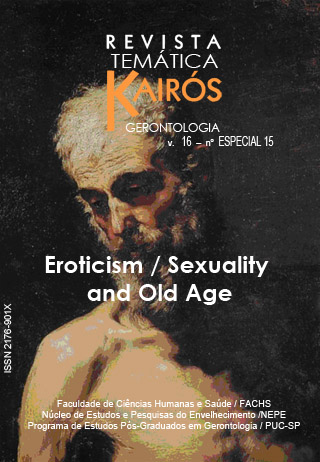Sexuality of the elder individual presented on paintings<br>A sexualidade de uma pessoa idosa apresentada em pinturas
DOI:
https://doi.org/10.23925/2176-901X.2013v16iEspecial15p227-242Palavras-chave:
Sexualidade, Idosos, PinturaResumo
A sexualidade da pessoa idosa tem uma história de negligência, vista como um tabu, tanto pela sociedade quanto pelo próprio indivíduo, contribuindo para manter os padrões culturais de opressão relacionadas ao tema da sexualidade relacionada ao envelhecimento. Na grande maioria das pinturas , o indivíduo mais velho é apresentado como um personagem assexual. A representação da pessoa idosa em pinturas é geralmente mostrada nos seguintes contextos: doméstico (“St Joseph, carpinteiro” - George de la Tour, 1642 ; “O Paralítico” - Jean Baptiste Greuze, 1763) e na decadência da saúde (“Velho na tristeza” - Van Gogh, 1890; “O velho guitarrista” – Picasso, 1903). Nas poucas pinturas que expõem a sexualidade do idoso, podemos ver uma clara predominência do sexo masculino (“Susana e os anciãos” - Artemisia Gentileschi, 1610; “Idoso nu ao sol” - Mariano Fortuny, 1871). A sexualidade da mulher mais velha é pouco referida, sendo a mulher predominantemente retratada em seu papel doméstico. Quando a sexualidade é mostrada é no contexto da prostituição, como na obra “O Salão I”, de Otto Dix, 1921. Entre os pintores do século 20, há autoretratos em que os artistas de ambos os sexos se pintam nus em idade avançada, mostrando uma tendência na mudança do paradigma atual: “Pintor de trabalho, Reflexão” - Lucian Freud, 1993, que retratou a si mesmo com a idade de 70 anos; e “Auto-retrato” - Alice Neel, 1980, aos 80 anos de idade.Downloads
Como Citar
Duarte, J. A., Oliveira, B. M. de, Ferreira, H. H. A., Bezerra, A. J. C., Vianna, L. G., & Bezerra, A. S. de A. (2013). Sexuality of the elder individual presented on paintings<br>A sexualidade de uma pessoa idosa apresentada em pinturas. Revista Kairós-Gerontologia, 16(Especial15), 227–242. https://doi.org/10.23925/2176-901X.2013v16iEspecial15p227-242
Edição
Seção
Artigos


